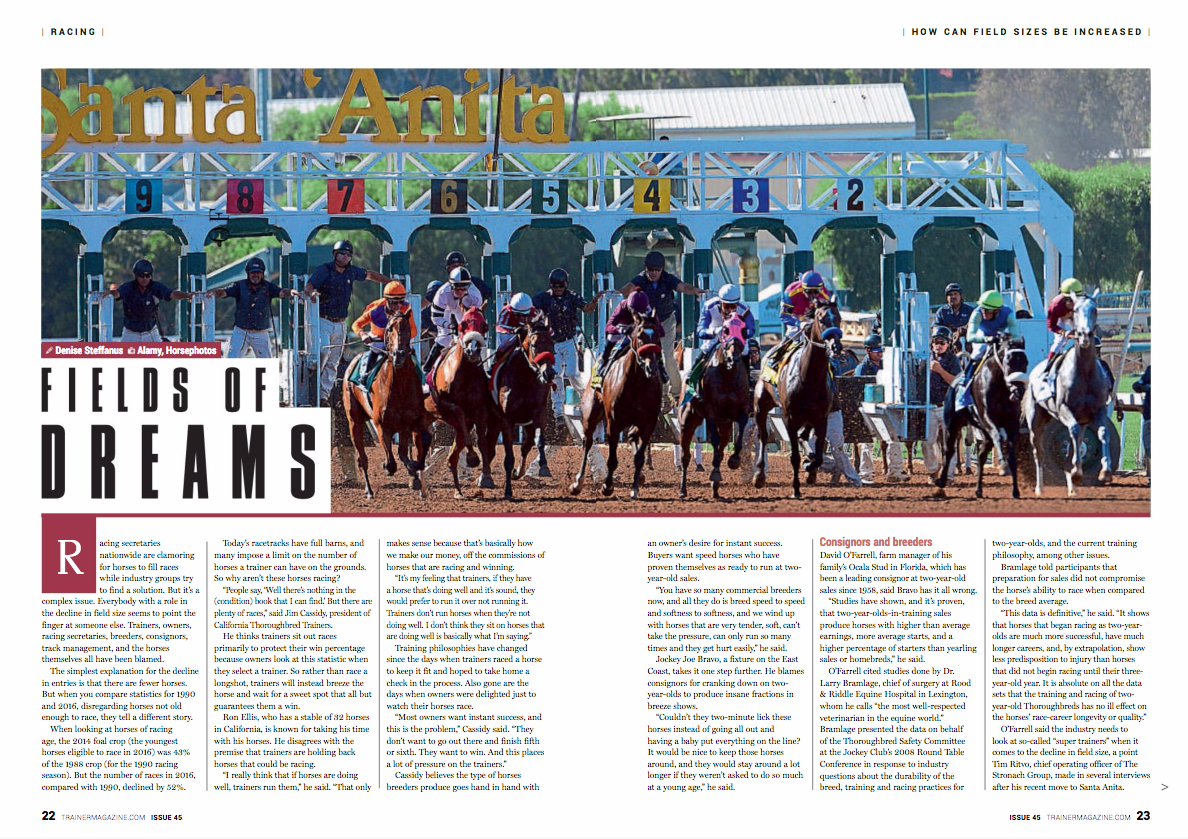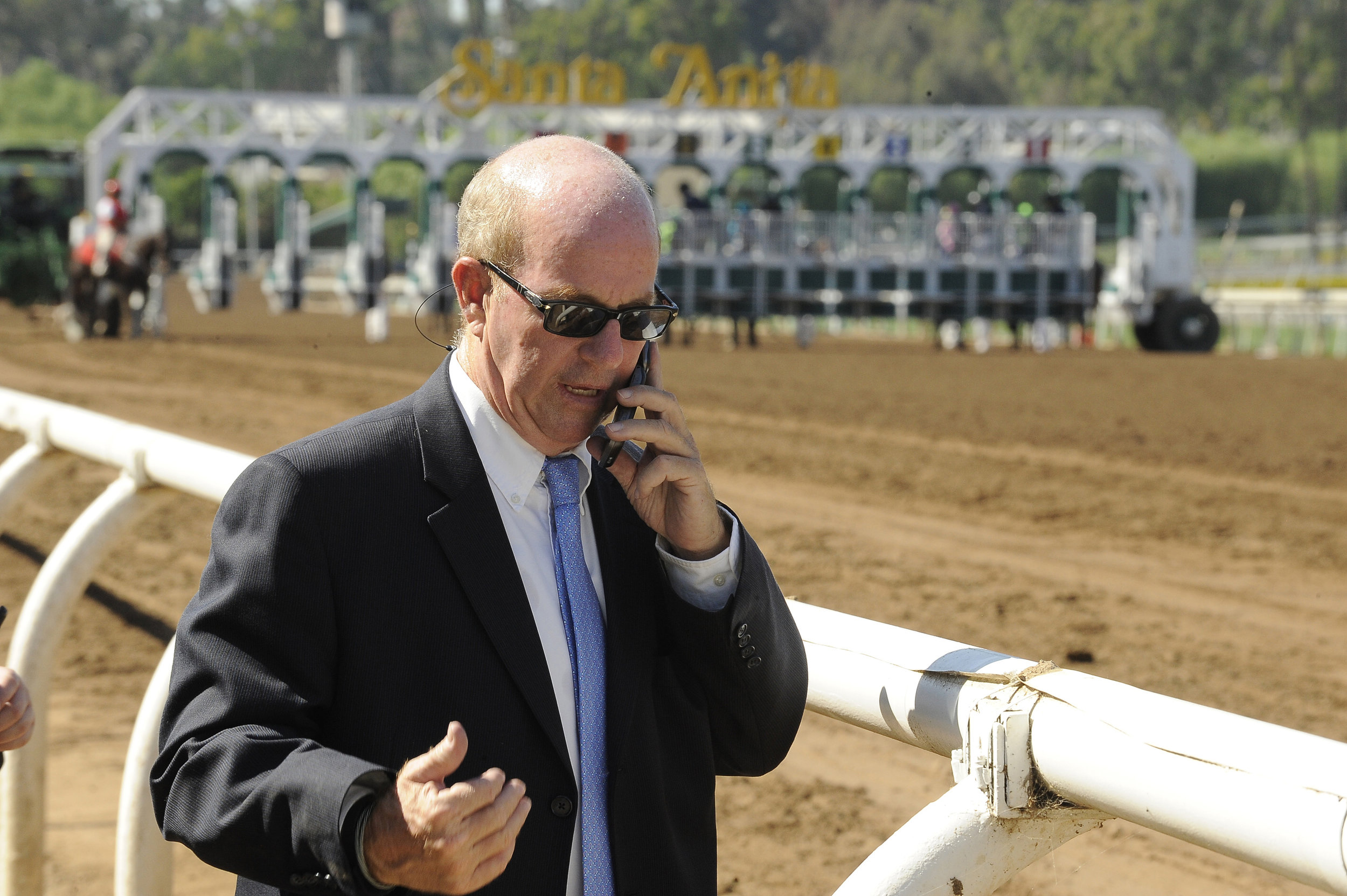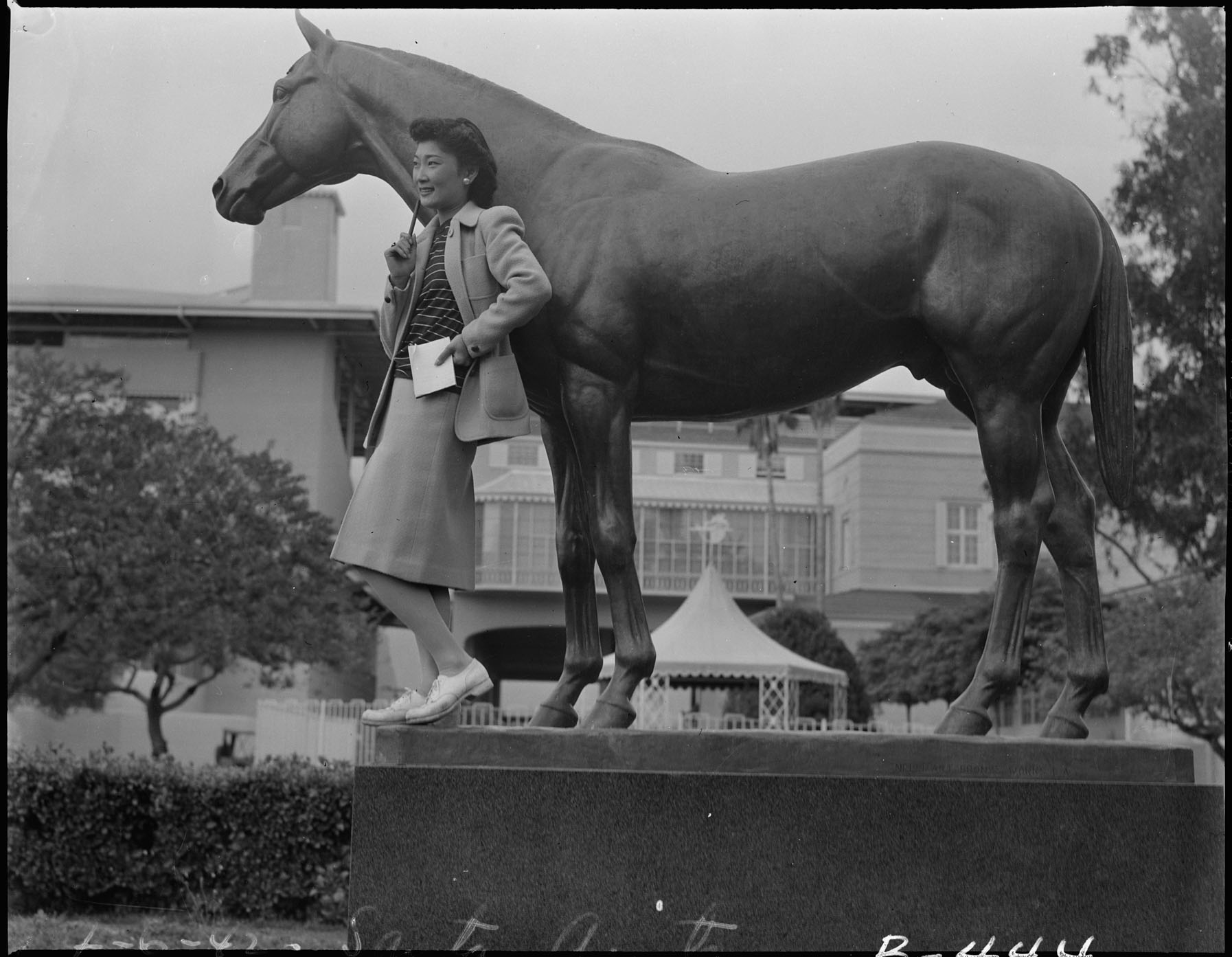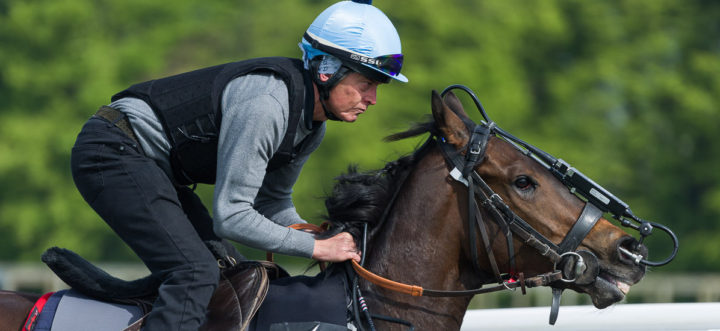Profile: Mike Stidham
“I’m a very self-conscious person who thinks a lot, worries a lot, and is a perfectionist. In this business, there’s not a lot of perfection.”
First published in North American Trainer August - October 2017 issue 45
Click here to order this back issue!
SEE OUR EXCLUSIVE PHOTOSHOOT
How do you reconcile a win-only mentality in a profession where a 25 percent success rate is as good as it gets?
“I struggle with it to this very day,” trainer Mike Stidham said. “If I expect a horse to win and he doesn’t, I don’t want anybody to be around me for a little time. I’ve always been a very competitive person. I’m an action junkie who loves competing and I want to win. It’s not the greatest way to live because it’s impossible to do.”
Fortunately for the 59-year-old conditioner, his horses have been winning more often than ever in his 38-year-old career as he builds a national presence after winning his first training title at the Fair Grounds in 2016, the same year he finished 36th overall in the country by earnings, with $3,747,766. That remains his most successful year to date thanks to a career-high 105 victories from 608 starts.
Those numbers are remarkable considering he was almost forced out of the business when he won just six races in 1989 and three in 1990.
Yet now, as he has his whole life, he wants more. He wants better.
“I’m the kind of person who’s hard on myself,” Stidham said. “I always want a reason why. ‘Why didn’t he run good? What did I do wrong?’ I’m a very self-conscious person who thinks a lot, worries a lot, and is a perfectionist. In this business, there’s not a lot of perfection.”
That didn’t prevent the late Hall of Fame jockey Bill Hartack, a close friend of Stidham’s family who was a mentor and like a kind uncle to Stidham, from feeling the same way.
“My mother would cook dinner and he would come over,” Stidham said. “One night, I asked my dad why Bill was so upset. My dad said, ‘He rode seven and only won five.’ When he was riding, he expected to win every race. When he didn’t, he wasn’t easy to be around. He was very serious. That’s why he was so successful.”
Hartack, though, just like Stidham, had a softer side. “He was two different people,” Stidham said. “When he came to our home on days he wasn’t riding, he was like a little kid. He really was. He took us to amusement parks and played with us. I think that was his release.”
Stidham’s now-84-year-old mother, Anita, agreed: “They would go to the movies. He’d take a lot of Michael’s friends to Disney. He’d take a day off and take all the kids to the movies all day long. They used to do fun things.”
After Hartack passed away in 2007, Stidham and several other friends established the Bill Hartack Charitable Foundation, which rewards each year’s winning Kentucky Derby jockey with a ring. Ticket sales for the event and ads in the program raise money, and the winning jockey chooses which charity he wants to help. Already, donations have been made to the Permanently Disabled Jockeys Fund, the Winners Foundation, and the Racing Employee Assistance Program. At the event, the Stidhams bring and display Hartack’s five Kentucky Derby trophies that he left them.
The Foundation gives Stidham’s mother another reason to smile about her son. “I couldn’t be any prouder,” she said. “He excels in everything he does and he’s a good person.”
And his over-competitive drive? “That I believe he got from Bill,” she said. “Michael was around him a lot growing up. He picked up some of Bill’s traits. Michael was very competitive, all his life, in everything he did. He always wants to win.”
Plantation Field: Racing goes Eventing
Words by Jenni Autry / Photos by Amy Dragoo
FIRST PUBLISHED IN NORTH AMERICAN TRAINER AUGUST - OCTOBER 2017 ISSUE 45
Two worlds are set to collide in September when the mid-Atlantic racing and eventing communities join hands to showcase the versatility of the Thoroughbred breed in idyllic Unionville, Pennsylvania.
Plantation Field International Horse Trials, known colloquially as the “Best Event Ever” thanks to its legendary parties on the grounds, will forego its usual theme weekend to instead devote Septemper 14-17 to honoring the Thoroughbred’s storied role in racing and eventing.
In announcing a multi-year partnership with Retired Racehorse Project (RRP), Plantation Field will celebrate excellence in Thoroughbred racing culture and bring together two groups that share the same desire to see Thoroughbreds thrive and flourish, both on the track and after their careers as racehorses are complete.
Steuart Pittman, RRP’s president, said he hopes the racing community will embrace the concept, venturing from the racetrack to the cross country course in the name of the Thoroughbred.
"We hope this will be a real coming together of the racing world with eventing so we can have a positive impact that will support both sports and ultimately the Thoroughbred in the long run,” Pittman said.
“The goal is to bring the racing community out to enjoy everything Plantation Field has to offer and introduce the Retired Racehorse Project as a resource. We can help owners, trainers, and breeders sell their horses through our resource directory. If we work together, we can successfully transition horses to second careers after the track.”
Eventing: An Equine Triathlon
Originally developed as a method for training military horses, eventing ultimately evolved into a sport that first appeared in the Olympic Games in 1912. Eventing is essentially an equine triathlon, combining the three phases of dressage, cross country, and show jumping into a sport that demands a well-rounded equine athlete.
Considering the grueling fitness test required in the cross country phase — when horses will gallop and jump for more than 10 minutes over as many as 45 obstacles at the highest level of the sport — the Thoroughbred’s gallop and stamina helped the breed find a stronghold in eventing.
Countless Thoroughbreds have taken top eventing honors in the U.S. and beyond, and the United States Eventing Association’s leaderboard of all-time high scoring horses shows three Thoroughbreds in the top 10.
Phillip Dutton knows all too well how perfectly suited the Thoroughbred is to eventing. Hailed the Angel Cordero of the eventing world by West Point Thoroughbreds’ Terry Finley, Dutton won two Olympic team gold medals in 1996 and 2000 for his native Australia — both times riding Thoroughbreds.
Since then Dutton has piloted many Thoroughbreds to top results around the world. He rode TruLuck, purchased off the track in Oklahoma, to team gold and individual silver at the 2007 Pan American Games.
The Foreman came to Dutton from Maryland steeplechase trainer Bruce Fenwick and also went on to have a dominant eventing career, placing second at the prestigious Burghley CCI4* and Kentucky CCI4* and sitting seventh on the list of U.S. all-time high scoring horses.
“When it comes to the cross country, no horse will have a better gallop, stamina, and natural athletic ability than a Thoroughbred,” Dutton said. “They also have an incredible amount of heart. When other horses will get tired and quit, the Thoroughbred will keep trying and keep going for you.”
Icabad Crane
Considering Dutton’s history of successfully training Thoroughbreds, he became Graham and Anita Motion’s first choice when they were looking for an eventing trainer to work with their Thoroughbreds.
The Motions first had the idea to send horses to Dutton for a shot at a second career when Icabad Crane retired from the track in 2013. Icabad Crane finished third in the 2008 Preakness Stakes and won or placed in 15 other stakes for owner Earle Mack, earning $585,980.
When he retired as an 8-year-old, the Motions took over ownership of Icabad Crane and knew the horse didn’t want to stand around in a field. They decided to send him to Dutton for training at True Prospect Farm, about seven miles from Plantation Field and an hour from the Motions’ base at Fair Hill Training Center in Maryland. It proved to be a match right from the start, with Dutton seeing Icabad Crane’s innate drive and desire to succeed in everything he did, which made his transition to an eventing career virtually seamless.
Click here to order this back issue!
“Icabad was always a very willing horse,” Graham said. “It’s one thing to be athletic, but he also always had the right attitude. His disposition absolutely helped in his new career.” Anita added: “Phillip wouldn’t have competed him if we didn’t think the horse had what it takes. Not only was there a real talent there, but Icabad wanted to do it.”Icabad Crane flourished in his new career, winning his first Beginner Novice event and going on to finish his first eventing season with a win in the $10,000 America’s Most Wanted Thoroughbred Contest, hosted by the RRP at Pimlico Racetrack in 2014.
Icabad Crane continued to rack up top results, culminating in a win in the Plantation Field CIC* in 2015 in his first start at the one-star level. The Motions proudly held the winner’s cooler that day, and since then they have traded roles with the Duttons, who joined in on the West Point Thoroughbreds partnership on Grade I winner Ring Weekend.
Now the Motions and Dutton hope the greater mid-Atlantic racing and eventing communities can unite at Plantation Field to build on what they started: joining two worlds that both hold an immense respect for the Thoroughbred.
"If we work together, we can successfully transition horses to second careers after the track"
Showcasing Thoroughbreds
The weekend will be dedicated to showcasing the breed, with the RRP taking center stage. The timing is ideal, as Plantation Field takes place annually three weeks prior to the $100,000 Thoroughbred Makeover and National Symposium, which this year goes from October 5-8 at the Kentucky Horse Park. With RRP now on board as Plantation Field’s beneficiary, the event will also serve as a preview show for Thoroughbreds that will compete in and ultimately be available for sale at the Makeover.
"That way people can see horses they like at Plantation Field and then go on to the Makeover to shop,” Pittman said. “There will be a number of really nice horses ready to start second careers, and we are excited to show them off at Plantation Field." Beyond that, Pittman said he hopes Plantation Field will serve as an opportunity for the racing world to see Thoroughbreds galloping across an entirely different type of track — one dotted with cross country jumps.
"What we've seen is that racing people love eventing when they take the time to go watch the sport,” Pittman said. “They get to see horses galloping on the cross country course, which is something they can get excited about.” In addition to previewing horses that will compete at the Thoroughbred Makeover, the RRP’s demonstration will also feature celebrity Thoroughbreds, including Makeover graduates from prior years. Icabad Crane will also make a special appearance with Dutton. "Icabad is a perfect example of what Thoroughbreds can do in second careers if given the chance,” Dutton said. “We are continually grateful to Graham and Anita for giving him that opportunity. Our hope is that when people see Icabad at Plantation Field they might be inspired to give a Thoroughbred a second career after the track, whether as a rider, owner, or trainer.”
The highlight of the weekend will be the Real Rider Cup, which will pit some of the biggest names in racing against each other for a show jumping competition in the main arena.
Rodney Jenkins, Rosie Napravnik, Joe Sharp, Sean Clancy, Michael McCarthy, Erin Birkenhauer, and Sanna Neilson will all make an appearance at the Real Rider Cup, with Zoe Cadman from XBTV acting as emcee for the event. More celebrity competitors will be unveiled in the countdown to Plantation Field. “The Thoroughbred community are intrigued with the eventing and show jumping world and are totally committed to providing other outlets for our retirees,” Anita said. “The Real Rider Cup event shows a fun side to this endeavor."
Dutton said he hopes Thoroughbred trainers, owners, and breeders will get involved in support of the RRP and second careers for racehorses. “Retired Racehorse Project is a perfect example of how we can help the transition from racing to a successful second career,” Dutton said. “By attending Plantation Field and supporting the event, you can bring greater attention, participation, and financial support to the successful transition Thoroughbreds can have.”
If You Go
In addition to three days of exhilarating competition, Plantation Field features a country fair atmosphere with a sprawling vendor village, a food court, and kid’s corner to provide entertainment for the whole family.
Admission to Plantation Field Horse Trials is free on Friday, September. 15, with general admission on Saturday, September 16 and Sunday, September 17 priced at $20 per carload.
For more information, visit www.plantationfieldht.com. Tickets and tailgate passes can be purchased in advance on the website. Follow Plantation Field on Facebook for news and updates.
Like this article? Subscribe now!
Or click here to order this back issue!
Why the grass is getting greener in New York
FIRST PUBLISHED IN NORTH AMERICAN TRAINER AUGUST - OCTOBER 2017 ISSUE 45
Click here to order this back issue!
PHOTO GALLERY
Thoroughbred racing on Long Island is changing so fast it’s hard to keep up. As the New York Racing Association (NYRA) made its annual seven-week summer pilgrimage to Saratoga, the future of racing at NYRA’s two Long Island racetracks, Belmont Park and Aqueduct, remains, in a single word, complex.
NYRA’s recent, stunning announcement that it was converting Aqueduct’s 40-year-old inner dirt track into a second turf course – the first major renovation of a NYRA track in decades – immediately prompted questions about Belmont Park and possible reconstruction that could close racing there for a year or longer.
It’s hard to believe that it’s being done solely to add a few grass races in April and November if the weather allows it. Regardless, having winter racing on Aqueduct’s main track will make it much more attractive to horsemen simply because it allows several different distances of races than the inner dirt track allowed.
The ongoing interest of the New York Islanders in building a new hockey arena on Belmont Park property may or may not have a lot do with Belmont Park’s future. Reportedly, a new arena would not affect Belmont’s existing grandstand and clubhouse. Reading that situation is a difficult task since New York State is involved and will have the ultimate say.
Then there was a bill that passed the New York State Senate in mid-June to allow evening racing at Belmont Park. The legislation didn’t make it out of the assembly but will be reintroduced next year. Meanwhile, in an interview with North American Trainer, NYRA CEO and President Chris Kay said that night racing is one of his priorities at Belmont.
Other things on Kay’s agenda, in conjunction with NYRA’s new Board of Directors named on June 7th, are incentive programs for two-year-olds and marathon turfers; making a concerted effort to attract European shippers and serve bettors in Japan; and a reshuffling of major stakes to be held on one day. Also, NYRA introduced a new multiple-race wager and a new partnership platform for messaging-enabled commerce.
What’s next?
To read more - subscribe here!
Duncan Taylor - Taylor Made Farms
FIRST PUBLISHED IN NORTH AMERICAN TRAINER AUGUST - OCTOBER 2017 ISSUE 45
Click here to order this back issue!
SEE OUR EXCLUSIVE GALLERY
Duncan Taylor, as president and CEO of Taylor Made Sales Agency, presides over the farm that bears his family name and has been at the heart of the bloodstock industry for more than four decades.
To many, the surname “Taylor” is synonymous with one of the leading U.S. sellers of bloodstock, but for those who attended the Pan-American Conference held in May in Washington, D.C., Duncan Taylor was simply the leading asker of questions.
It is clear that Taylor has always had a passion to learn about and understand different aspects of the business. Taylor Made provides services, but these are just some elements to a much bigger industry, and for the industry to grow, it must explore and embrace the different aspects that make the business what it is. This made the Pan-American Conference a “must-attend” event for Taylor, giving him the opportunity to question and learn from panelists and delegates from around the world.
Sitting down with Taylor at the conclusion of the conference the Sunday after the Preakness gave us the opportunity to get his thoughts on the industry.
Fields of Dreams
FIRST PUBLISHED IN NORTH AMERICAN TRAINER AUGUST - OCTOBER 2017 ISSUE 45
Click here to order this back issue!
PHOTO GALLERY
Racing secretaries nationwide are clamoring for horses to fill races while industry groups try to find a solution. But it's a complex issue.
Everybody with a role in the decline in field size seems to point the finger at someone else. Trainers, owners, racing secretaries, breeders, consignors, track management, and the horses themselves all have been blamed.
The simplest explanation for the decline in entries is that there are fewer horses. But when you compare statistics for 1990 and 2016, disregarding horses not old enough to race, they tell a different story.
When looking at horses of racing age, the 2014 foal crop (the youngest horses eligible to race in 2016) was 43% of the 1988 crop (for the 1990 racing season). But the number of races in 2016, compared with 1990, declined by 52%.
Today's racetracks have full barns, and many impose a limit on the number of horses a trainer can have on the grounds. So why aren't these horses racing?
"People say, 'Well there's nothing in the [condition] book that I can find.' But there are plenty of races," said Jim Cassidy, president of California Thoroughbred Trainers.
He thinks trainers sit out races primarily to protect their win percentage because owners look at this statistic when they select a trainer. So rather than race a longshot, trainers will instead breeze the horse and wait for a sweet spot that all but guarantees them a win.
Ron Ellis, who has a stable of 32 horses in California, is known for taking his time with his horses. He disagrees with the premise that trainers are holding back horses that could be racing.
"I really think that if horses are doing well, trainers run them," he said. "That only makes sense because that's basically how we make our money, off the commissions of horses that are racing and winning.
"It's my feeling that trainers, if they have a horse that's doing well and it's sound, they would prefer to run it over not running it. Trainers don't run horses when they're not doing well. I don't think they sit on horses that are doing well is basically what I'm saying."
Training philosophies have changed since the days when trainers raced a horse to keep it fit and hoped to take home a check in the process. Also gone are the days when owners were delighted just to watch their horses race.
To read more - subscribe here!
The morning riders who make the afternoon horses
“They’re your last source of information. As far as working horses is concerned, you need a good work rider at your barn”
FIRST PUBLISHED IN NORTH AMERICAN TRAINER AUGUST - OCTOBER 2017 ISSUE 45
Click here to order this back issue!
PHOTO GALLERY
Exercise, as described by that consummate wordsmith, Noah Webster, is “an activity that requires physical or mental exertion, especially when performed to develop or maintain fitness.”
To that end, one could say exercise riders are a Thoroughbred’s personal trainer.
They spend considerable time with the horses, and are responsible for riding them during their exercise runs on the track, be they jogs, gallops, or breezes.
They work closely with each horse’s trainer to keep the steed at peak performance level and provide feedback regarding its condition. Exercise riders can be hired by a trainer, a stable, or work freelance.
Trainers also employ jockeys to work horses, but there are beneficial differences to using an exercise rider.
“Jockeys are lighter in weight than exercise riders and horses breeze a little bit faster with them on,” said former jockey Art Sherman, who trained two-time Horse of the Year California Chrome. “If I don’t want my horse to work too fast, I like exercise boys on them for slower works, because they are heavier (weighing as much as 30-to-40 pounds more than a jockey).
“If you want a faster work and put a jock on, that’s fine, but prepping for a race, I like to have the exercise boy on.”
Trainer Peter Eurton’s stepfather was trainer Steve Ippolito, for whom Eurton exercised horses before weight issues ended his career as a jockey, so he knows first-hand the value of an exercise rider.
“They are one of many people who are really important to your barn,” said Eurton, who runs one of the most diversified and successful operations in California. “They’re your last source of information. As far as working horses is concerned, you need a good work rider at your barn and fortunately we have one in Pepe (Jose Contreras).
“Jockeys are okay, but sometimes they can be a bit apprehensive giving you the news straight, especially if it’s not what you want to hear. In a sense, they have a vested interest, so you have to take what they say with a grain of salt, although for the most part, riders do a really good job.”
One such jockey is ‘The Man with the Midas Touch,’ Mike Smith, North America’s leading money earner through June of 2017 with more than $14 million, and that’s not counting the $6 million gleaned when he rode Arrogate to victory in the Dubai World Cup in March.
Smith’s horses have earned enough purse money this year to balance the budget of a Third World country.
The Hall of Fame member, still in peak form as he turns 52 on August 10, maintains that horses are creatures of habit and benefit from a solid foundation, the first level of which is laid by exercise riders.
“I use this analogy,” Smith said. “If you send your kids to a bad school, they’re not going to learn what’s right. You’ve got to send them to the best school possible, and it’s the same with horses and exercise riders.
“They’re teaching them everything they need to know for the afternoons. If they’re not receiving proper instructions in the mornings, they’re certainly not going to get it right in the afternoon.”
Sid Fernando - The Horseracing Integrity Act of 2017
FIRST PUBLISHED IN NORTH AMERICAN TRAINER AUGUST - OCTOBER 2017 ISSUE 45
Click here to order this back issue!
The current political regime – as opposed to the previous one – favors diminished government, deregulation, states’ rights, American isolationism/anti-globalism, and anti-immigration, yet into this discernible climate change we as an industry are charging head first to effect changes at odds with these precepts.
Making the entire process comical is that most industry participants, from wealthy owners and breeders at The Jockey Club to blue-collar owners and trainers in the provinces, are Republicans who supported this regime in the voting booth, even though we never support each other on myriad industry issues.
This, surely, must make us headless horsemen, because we’re probably going to get our heads handed to us on a platter from this regime just as we do from each other. Simply, we engage in mutually destructive warfare because we don’t have the type of leadership to cross the aisle, compromise, and steer a clear course for the benefit of all.
To read more - subscribe now!
Laryngeal Problems - Hocus pocus or cutting edge science?
FIRST PUBLISHED IN NORTH AMERICAN TRAINER AUGUST - OCTOBER 2017 ISSUE 45
Click here to order this back issue!
PHOTO GALLERY
Recurrent laryngeal neuropathy (RLN) is the correct term for the condition better known as roaring or laryngeal hemiplegia. It is extremely common in Thoroughbreds and represents one of the major causes of poor performance or jockey-reported noise.
Because it is so important, many young horses are scoped at sales looking for laryngeal asymmetry to try to identify those that may be at risk of having this condition. But scoping at rest is fraught with difficulty – the larynx may be normal at rest only to show signs of weakness during exercise, so positive cases can be missed.
Conversely, tired young horses can have apparently poor laryngeal function at rest that in fact is of little significance. Many question whether subjecting foals and young horses to endoscopy at sales is reasonable, although in part this latter concern is reduced now that videoendoscopy is available.
Furthermore, the dynamic endoscopy, overground or on a treadmill, is widely accepted as the best way to evaluate horses suspected of having upper airway disorders leading to dynamic obstruction of the airway during exercise, a population that may or may not have obviously abnormal throats when examined at rest.
Nevertheless, there is a need for better tools to evaluate the larynx for clinical application and also to allow researchers to study the condition in more detail. Two recent studies published in Equine Veterinary Journal have addressed this issue..
To read more - subscribe here!
No foot, no horse
FIRST PUBLISHED IN NORTH AMERICAN TRAINER AUGUST - OCTOBER 2017 ISSUE 45
Click here to order this back issue!
PHOTO GALLERY
The expression ‘no foot no horse’ is one that has stood the test of time, and discussions about hoof shape, horn quality, and foot conformation continue to dominate in the Thoroughbred racing and breeding industry.
Thoroughbreds in particular have a reputation, perhaps undeserved, for poor foot conformation but can frequently experience problems relating to either hoof horn quality or growth rate during their training careers. An inability to retain shoes, the appearance of hoof cracks, thin soles, white line disease, and brittle or crumbly feet are all practical issues related to horn quality that trainers may experience in some horses.
While it is easy to perhaps appreciate familial traits in foot conformation and hoof shape, experts also suggest that hoof horn quality is also influenced by genetic factors as well as nutrition, environment, and farriery. Stable cleanliness is also very important, with studies showing that equine feces have a very detrimental effect on hoof horn integrity, especially where the structure of the horn is not robust.
The focus of this article is the influence of diet on the hoof and how this relates to a typical racing ration. Hooves contain a large amount of protein, roughly 90% on a dry matter basis, and the most abundant structural protein present is keratin, which contains approximately 18 different amino acids. These chains of amino acids give keratin its primary structure, and the orientation and interconnection of these chains then gives a specialized secondary structure that relates to location and its function.
The hoof tissues are complex and show a high level of differentiation to deliver functionality. For example, keratin in the hoof capsule is rich in disulphide bonds (double sulphur bonds) that bridge two cysteine amino acids to form cystine to deliver hardness and strength, whereas the keratin found in the frog and white line region have less of these disulphide bonds (S=S) and more sulfhydryl bonds (S=H), affording less strength but more flexibility.
Methionine is a dietary essential sulphur containing amino acid, i.e. it cannot be synthesized from other amino acids in the body. Methionine can be converted to cysteine, which is integral to the form and function of keratin, and is a limiting amino acid in the equine diet, together with lysine and threonine.
Alan Balch - Self-interest rightly understood
“Is that really in the best interest of the horse or the breed? Is it justified by anything other than economic interests of the few as opposed to the many? ”
FIRST PUBLISHED IN NORTH AMERICAN TRAINER AUGUST - OCTOBER 2017 ISSUE 45
Click here to order this back issue!
When Viscount Alexis de Tocqueville journeyed from France to philosophize about “Democracy in America” in the early 1800s, he didn’t have racing in mind as he developed his observations on that distinctly American virtue of self-interest rightly understood. Over the last half-century, however, I’ve often thought of them as I’ve observed the evolution of our racing, particularly in California, first from the standpoint of track operators, and lately from the standpoint of horsemen.
I was originally a suit with responsibilities of marketing and managing Santa Anita, later adding Golden Gate Fields and Bay Meadows. I brought a perspective to my work that began with horses, since my earliest profession in the sport was handling their cleanliness and bodily functions. As with so many of us. I always wondered at and about the majesty and attraction of racing to the masses, over centuries, which seemed to survive and prosper despite our many gross mistakes and calamities in its management.
Wherever in the world you look, racing has been a regulated sport from its very earliest days. Which is to say that governmental authorities learned almost from day one that complete freedom in its operation would lead inevitably to scandal and swindle involving one participant or another. Most often, the “public” would be victimized; this led to regulations constantly citing the “public interest” upon their promulgation. And that, in turn, led to innumerable scandals and swindles based on various official scoundrels reaping their own harvests off unsuspecting victims, always in the name of the “public interest.”
I cite this sordid history not to entertain but to educate: what is loosely referred to as “the free market” doesn’t exist in contemporary racing. If it ever did, in fits and starts, it was squashed, altered, or hindered. By statute, regulation, and rule. Even the vaunted principle of caveat emptor, which is the mother’s milk of buying and selling horses, has been under assault by regulators and governments forever. Yes, the buyer should beware, but first let us accord him the government’s “protection” in all kinds of ways (just read the fine print in any sale catalogue), and provide him access to courts if he still claims to have been unaware of his risks.
And then there’s the routine interference in the “free market” by stud books themselves, and their own rules. Let’s see now . . . requiring live cover? Is that really in the best interest of the horse or the breed? Is it justified by anything other than economic interests of the few as opposed to the many? The very idea that there are true free markets even for our breeding and selling is sheer nonsense.
To read more - click here to subscribe!
Trainer of the Quarter - Peter Miller
FIRST PUBLISHED IN NORTH AMERICAN TRAINER AUGUST - OCTOBER 2017 ISSUE 45
Click here to order this back issue or
SUBSCRIBE NOW!
Don't forget the jockey
“Simulators allow carefully controlled, safe, and cost-effective training environments that can be used for prolonged periods to improve fitness, train neural pathways, and develop muscle memory”
FIRST PUBLISHED IN NORTH AMERICAN TRAINER AUGUST - OCTOBER 2017 ISSUE 45
Click here to order this back issue!
PHOTO GALLERY
The interaction between horse and jockey in racing is a fundamental partnership that can be optimized to achieve peak performance.
Performance benefits have been demonstrated for major changes in jockey technique such as the change from seated to the modern martini glass posture. However, if the partnership between horse and jockey does not work effectively together in a synchronized and complementary manner then, irrespective of the ability of the horse, performance may be constrained and the risk of injury of both horse and jockey may be increased.
Jockey training techniques have developed rapidly in recent years to involve sport-specific fitness training and technique optimisation, often using mechanical racehorse simulators. Simulators allow carefully controlled, safe, and cost-effective training environments that can be used for prolonged periods to improve fitness, train neural pathways, and develop muscle memory. Simulator training allows the jockey and coach to focus on specific elements of technique with immediate and detailed feedback, which in some cases can include physical manipulation to improve position and help jockeys to ‘feel’ the correct posture. Furthermore, additional skills such as correct use of the whip can be practiced in a safe, repeatable, welfare friendly environment.
Our research set out to characterize optimum jockey technique, measure the similarities and differences between simulators and real horses, and to measure changes in ability between jockeys of different experience levels. Using wireless sensor technology we have identified targets for skill optimisation with the potential to form the basis for improved feedback to jockeys during training.
To read more - subscribe now!
No Place for Negligence: Limiting Your Liability in Unique Situations
“If a horse gets out of control and causes injury on the backside, in the paddock, or winner’s circle, who is liable? You, as the trainer? The owner? The track? All of the above?”
FIRST PUBLISHED IN NORTH AMERICAN TRAINER AUGUST - OCTOBER 2017 ISSUE 45
Click here to order this back issue!
PHOTO GALLERY
Tom was brimming with confidence as he and the groom led his hottest prospect into the winner’s circle following a win in an allowance race on the turf.
An experienced trainer, Tom was sure that everyone’s hard work would pay off, and it had. But in a matter of moments, his excitement and exuberance turned into concern. In addition to horses, grooms, and trainers, the winner’s circle was crowded with excited and exuberant spectators, many of whom appeared to have spent little or no time around horses. Tom knew that group ticket packages often included photos in the winner’s circle. He appreciated the importance of promoting the sport and creating new fans. But this seemed like too much.
Tom, the groom, and their horse were soon surrounded by excited guests. The trainer and the groom warned people not to get too close. They tried to be polite and answer questions as the visitors snapped pictures with smartphones. Unfortunately, one would-be fan didn’t realize his flash was on, and three bright bursts of light erupted just a few feet from the horse’s face. The Thoroughbred spun and kicked the man in the chest, sending him crashing to the ground. Tom and the groom managed to get the horse under control quickly to prevent additional injuries. The EMTs arrived and rushed the man to the hospital.
Tom’s big day literally ended in a flash. A few weeks later, he was served legal papers. The injured man was suing him for negligence.
The situation I have just described is hypothetical. However, the legal implications are very real. As a trainer, you are responsible for large, powerful, and often high-strung animals in a variety of situations; situations that are far more fluid and complex than a casual observer could possibly realize. If a horse gets out of control and causes injury on the backside, in the paddock, or winner’s circle, who is liable? You, as the trainer? The owner? The track? All of the above?








































































